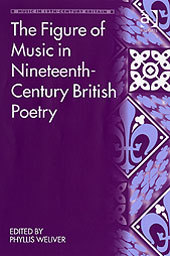The Figure of Music in Nineteenth-Century British Poetry Music in Nineteenth-Century Britain Series
Coordonnateur : Weliver Phyllis

Contents: Introduction; Scotch drink & Irish harps: mediations of the national air, Celeste Langan; 'Suspended' sense in Alastor: Shelley's musical trope and 18th-century medical discourse, Kimiyo Ogawa; On music framed: the Eolian harp in romantic writing, Susan Bernstein; Music and inspiration in Blake's poetry, John Hughes; 'Music their larger soul': George Eliot's 'The Legend of Jubal' and Victorian musicality, Ruth A. Solie; Musical reactions to Tennyson: reformulating musical imagery in 'The Lotos-Eaters', Michael Allis; 'Monna Innominata' and Christina Rossetti's audible unhappiness, Yeo Wei Wei; The 'silent song' of D.G. Rossetti's The House of Life, Phyllis Weliver; 'The Music Spoke for Us': music and sexuality in fin-de-siècle poetry, Emma Sutton; Sappho recomposed: a song cycle by Granville and Helen Bantock, Yopie Prins; Index.
Date de parution : 09-2005
15.6x23.4 cm
Date de parution : 11-2016
15.6x23.4 cm
Thème de The Figure of Music in Nineteenth-Century British Poetry :
Mots-clés :
Monna Innominata; aeolian; Scots Musical Museum; harp; Scots Musical Traditions; Celeste Langan; Nineteenth Century British Poetry; Kimiyo Ogawa; Eighteenth Century Medical Discourse; Susan Bernstein; Aeolian Harp; John Hughes; Sapphic Song; Ruth A; Solie; Nineteenth Century British Musicology; Michael Allis; Michael Field; Yeo Wei Wei; Eolian Harp; Emma Sutton; Rossetti’s Sonnet; Yopie Prins; True Innocence; Granville Bantock; Sapphic Stanza; Irish Melodies; Sappho Songs; Young Man; Sinfonia Eroica; Blake’s Work; Scotch Drink; Musical Allusions; Nature’s Law; Classical Lyric Musicians; Propyl Formate; Nineteenth Century Poetry



